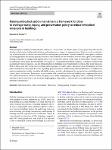Item Infomation
Full metadata record
| DC Field | Value | Language |
|---|---|---|
| dc.contributor.author | Teicher, Hannah M. | - |
| dc.date.accessioned | 2023-08-04T04:48:16Z | - |
| dc.date.available | 2023-08-04T04:48:16Z | - |
| dc.date.issued | 2023 | - |
| dc.identifier.uri | https://link.springer.com/article/10.1007/s13412-023-00836-7 | - |
| dc.identifier.uri | https://dlib.phenikaa-uni.edu.vn/handle/PNK/8674 | - |
| dc.description | CC_BY | vi |
| dc.description.abstract | With anticipation building around embodied carbon as a “new frontier” of climate policy, it may appear that cities need to develop a whole suite of dedicated institutions and mechanisms to support its implementation. However, to do so risks placing an undue burden on already overstretched local and regional governments. Instead, embodied carbon policy can build on existing priorities that already galvanize resources and attention and have benefited from decades of policy development. Making strong links to a larger urban agenda offers a way to forge buy-in from a wide range of stakeholders. Current visions for embodied carbon policy broadly fall into two categories: (1) material substitution strategies, or technical solutions that incrementally reduce emissions, and (2) demand reduction strategies, more transformative solutions that avoid emissions. | vi |
| dc.language.iso | en | vi |
| dc.publisher | Springer | vi |
| dc.subject | new frontier | vi |
| dc.subject | carbon mainstream | vi |
| dc.title | Making embodied carbon mainstream: a framework for cities to leverage waste, equity, and preservation policy to reduce embodied emissions in buildings | vi |
| dc.type | Book | vi |
| Appears in Collections | ||
| OER - Khoa học môi trường | ||
Files in This Item:

